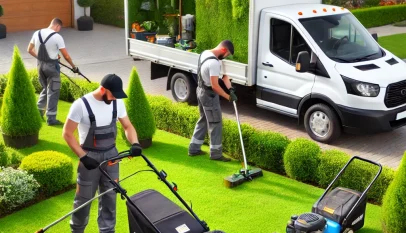Mississauga Landscaping: Transforming Outdoor Spaces with Professional Expertise
Mississauga boasts a vibrant mix of urban living and natural beauty, making landscaping an essential consideration for homeowners and businesses alike. Creative landscaping can enhance property value and create inviting outdoor spaces tailored to individual needs.
From selecting the right plants for the climate to incorporating sustainable practices, Mississauga’s landscaping options are diverse and exciting. Engaging local professionals can lead to innovative designs that reflect personal style while complementing the local ecosystem.
This article will explore the latest trends and practical tips in Mississauga landscaping, helping readers transform their outdoor spaces into stunning retreats. Whether someone is a seasoned gardener or just starting, there are valuable insights to be gained.
Designing Your Landscape in Mississauga
Designing a landscape in Mississauga involves understanding the local environment, selecting appropriate plants, planning for water management, and creating functional outdoor spaces. Each of these elements plays a vital role in achieving a beautiful and sustainable landscape.
Understanding Local Climate and Soil
Mississauga experiences a humid continental climate, characterized by warm summers and cold winters. The average summer temperature hovers around 25°C, while winters can dip below -10°C. Recognizing these temperature fluctuations is critical for plant choice.
The soil in Mississauga varies but is often clay-heavy, which can impact drainage and plant health. Conducting a soil test can help determine nutrient levels and pH, guiding amendments for optimal plant growth. Recommended soil improvements include:
- Adding organic matter
- Adjusting pH levels
- Ensuring good drainage
Selecting Plants and Materials
Choosing the right plants is essential for a successful landscape design. Native plants, such as the Eastern Redbud or Black-eyed Susan, thrive in local conditions and support regional wildlife. Incorporating a mix of evergreens and deciduous plants can provide year-round interest.
When selecting materials, consider using durable, low-maintenance options. Hardscape elements like stone, brick, and concrete can accent gardens while enhancing durability. Creating a plant list can help streamline the selection process. Include:
- Native perennials
- Shrubs that bloom in different seasons
- Ornamental grasses for texture
Irrigation and Drainage Considerations
Effective irrigation is crucial for plant health, especially during dry spells. Drip irrigation systems or soaker hoses provide efficient watering directly to roots. Rain barrels can also capture rainwater, offering an eco-friendly moisture source.
Drainage must be assessed to prevent standing water, which can cause root rot and other issues. Simple solutions include:
- Installing French drains
- Creating swales for water diversion
- Incorporating permeable paving
Outdoor Living Spaces and Features
Incorporating outdoor living spaces enhances both usability and aesthetics. Patios, decks, and fire pits can add functionality to the landscape. These areas should be carefully positioned to maximize sunlight and views.
Considerations for outdoor features include:
- Seating arrangements for entertaining
- Landscaping around features for integration
- Lighting to extend usability after dark
These design elements contribute to creating inviting, functional spaces that encourage outdoor enjoyment in Mississauga’s diverse climate.
Maintaining Your Mississauga Garden
Keeping a garden in Mississauga healthy requires attention to a few key areas: lawn care, pruning, and seasonal cleanup. Each aspect plays a vital role in ensuring that the garden remains vibrant throughout the year.
Lawn Care and Maintenance
A beautiful lawn starts with proper care. Mowing should occur regularly, ideally once a week during the growing season. This encourages thick growth and discourages weeds.
Watering is also crucial. Lawns need about 1 inch of water per week, especially during dry spells. Deep watering encourages root growth, making grass more resilient.
Fertilization should happen at least twice a year, using a slow-release fertilizer tailored for the region. This supports growth and strengthens the lawn against pests and diseases.
Weed control can involve both pre-emergent herbicides and manual removal. Keeping the lawn edges trimmed also protects against encroaching weeds.
Pruning and Plant Health
Pruning is essential for maintaining plant health. It removes dead or diseased branches, allowing more light to penetrate. This encourages healthy growth and flowering.
Spring is a great time to prune many flowering shrubs. Late summer pruning helps maintain shape while promoting bushier growth.
Inspect plants regularly for pests like aphids or spider mites. Early detection helps in managing infestations effectively. Applying insecticidal soap can address minor infestations without harming beneficial insects.
Mulching around plants conserves moisture and suppresses weeds. Organic mulch also decomposes, enriching the soil as it breaks down.
Seasonal Cleanup and Preparation
Seasonal cleanup is critical for garden health. In fall, remove fallen leaves and debris to prevent mold and pests.
Cut back perennials after the first frost to tidy up the garden. This process helps plants prepare for winter while also enhancing aesthetic appeal.
In spring, focus on soil preparation. Testing soil pH ensures proper amendments are made. Adding compost will boost fertility, benefiting all plants.
During spring cleanup, check for winter damage and replace any dead plants. This proactive approach supports a healthy, attractive garden throughout the growing season.
Rent Mini Excavator Near Me: Finding the Best Local Options for Your Project
Finding a reliable rent mini excavator near me service can significantly streamline constr…











